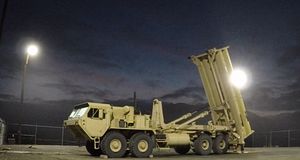On Sunday, the United States Missile Defense Agency (MDA) announced that the Terminal High Altitude Area Defense (THAAD) system had successfully passed an intercept test of a medium-range ballistic missile (MRBM) target.
According to a statement released by the Agency, a THAAD battery located at the Pacific Spaceport Complex Alaska in Kodiak, Alaska “detected, tracked and intercepted” an MRBM-class ballistic missile target that was air-launched by a U.S. Air Force C-17 over the Pacific Ocean. MDA released video footage of the test.
“In addition to successfully intercepting the target, the data collected will allow MDA to enhance the THAAD weapon system, our modeling and simulation capabilities, and our ability to stay ahead of the evolving threat,” said MDA Director Lt. Gen. Sam Greaves, according to a statement released by MDA.
This test was the 15th success in 15 trials for THAAD since 2005, when they system began operational testing. Sunday’s test comes weeks after the system’s first-ever successful intercept test against an intermediate-range ballistic missile (IRBM) target.
Despite the proximity of these two recent THAAD tests to successive North Korean ballistic missile launches, the MDA had long accounted for this type of testing in the 2017 fiscal year. Additionally, THAAD has no capability against the missiles North Korea demonstrated on July 4 and July 28, both of which were intercontinental-range ballistic missiles.
The United States has deployed THAAD in South Korea, with the launchers arriving in the country in early May 2017, despite sharp opposition from China, which sees the X-band AN/TPY-2 radar associated with the system as a threat to its security.
Following North Korea’s latest ballistic missile test on Friday, South Korean President Moon Jae-in ordered discussions with the United States on the deployment of an additional four THAAD batteries. Moon had suspended the deployment of those batteries pending an environmental assessment following allegations that the South Korean military had attempted to cut his office out of decision-making related to THAAD’s deployment.
In 2016, Moon, as an opposition leader, had opposed the deployment of THAAD. He softened his opposition in early 2017 before declaring his candidacy for South Korea’s early election in May.
THAAD uses a hit-to-kill interceptor to kinetically destroy ballistic targets in their terminal stage. The system has been demonstrated to be effective against short-, medium-, and intermediate-range ballistic missile targets.
In South Korea, the system will be primarily used to defend the southern half of the country, covering primarily U.S. military assets against North Korean attack. The single THAAD battery in South Korea, in Gyeongsanbuk-do, will not provide coverage to Seoul.

































